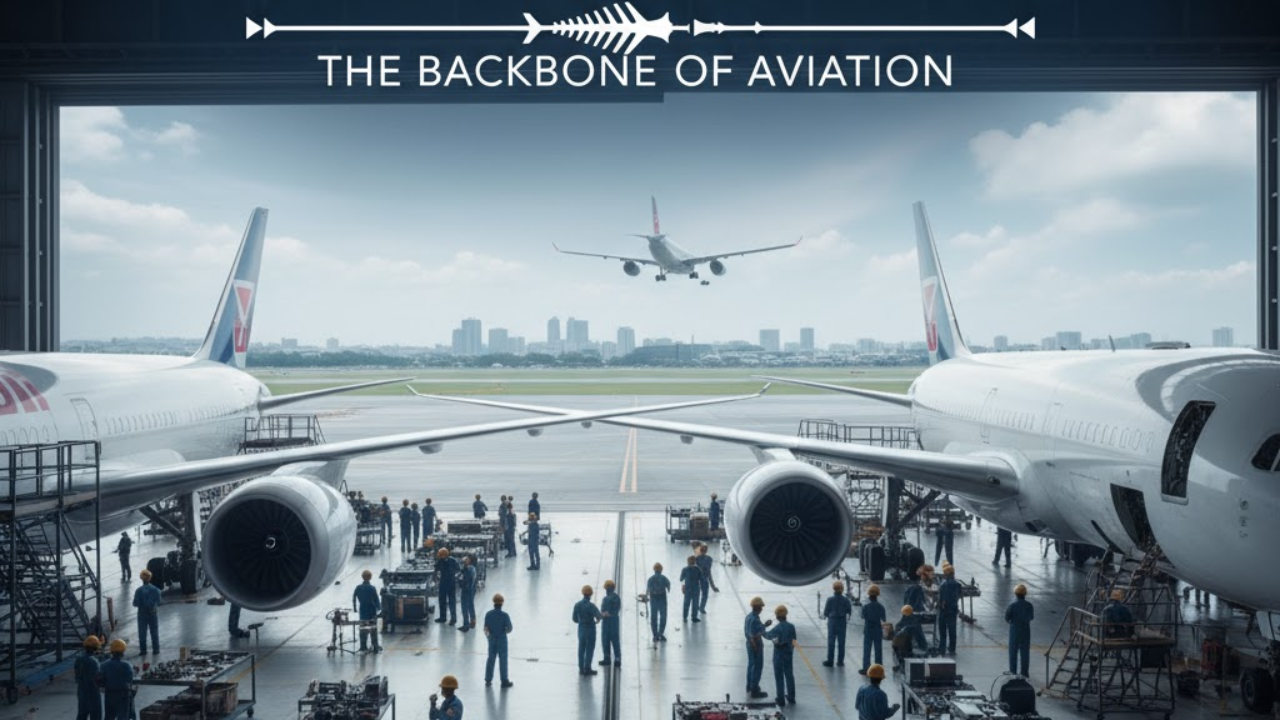
Post by : Meena Rani
In aviation, the beauty of flight is often taken for granted — yet every aircraft in the sky depends critically on the MRO industry (Maintenance, Repair & Overhaul). From engine overhauls and airframe repairs to avionics checks and cabin refurbishments, MRO firms ensure safety, reliability, and uptime. In many ways, MRO is the backbone of aviation’s operational integrity.
The global aircraft MRO market is already large and expanding. In 2024, it was estimated at USD 90.85 billion, with forecasts projecting it to reach as high as USD 120.96 billion by 2030. (CAGR ~4.75 %) Markets vary by region, but Asia-Pacific, Latin America, and the Middle East show especially strong upside.
Another projection sees the MRO industry growing at ~2.7 % annually through 2035, driven by fleet expansion, aging aircraft, and higher utilization. In 2024, global MRO spending surpassed the pre-COVID peak, hitting over USD 114 billion.
These trends reflect a “super-cycle” in MRO demand—when older aircraft, stretched service intervals, and rising flight activity push maintenance needs upward across the board.
The world’s commercial fleet is forecast to grow from ~29,000 aircraft in 2025 to ~38,300 by 2035 (a ~2.8 % annual growth rate). As new aircraft enter service and older ones stay longer, more scheduled inspections, repairs, and checks are needed.
Many airlines are deferring retirements or converting older jets into freighters, putting extra stress on maintenance schedules.
Airlines are pushing planes harder to recover revenues, squeezing time between flights. Turnaround windows shrink, making rapid maintenance and reliability ever more critical. Downtime is expensive — every grounded plane is lost revenue.
MRO is no longer purely mechanical. Digital transformation is reshaping how work is done:
Predictive maintenance using AI, condition monitoring, and data analytics to forecast failures before they occur
Digital twins of engines or airframes to simulate stresses and plan interventions
Augmented reality (AR) and remote guidance systems to assist technicians
Additive manufacturing / 3D printing of spare parts to reduce lead times and stockpile pressure
These innovations aim to cut downtime, lower cost, and improve safety.
Sourcing parts and components is a perennial challenge. Geopolitical tensions, raw-material shortages, logistics delays, and limited inventories can all block smooth operations. Many MROs now emphasize supply chain resilience: diversifying vendors, localizing sourcing, and building buffer inventory.
MRO is labor-intensive and highly skilled. Many veteran technicians are retiring, and attracting new talent is tough. Training, certification, and retaining staff are high priorities. MRO firms must balance automation with hands-on expertise.
Each region (FAA, EASA, CAAC, etc.) has strict regulatory standards for safety, maintenance, and approvals. New technologies must also mesh with compliance. MRO firms often need to navigate multiple certifications, audits, and regulatory intricacies.
Cost pressures & margin squeeze: Airlines are cost-conscious, pushing MROs to perform faster and cheaper without compromising safety.
Investment burden: Upgrading tooling, digital systems, and training is expensive, especially for smaller MRO operators.
Integration & consolidation: The industry is consolidating. Large players are absorbing smaller ones to gain scale; but merging systems, culture, and operations is tough.
Downgrade risk: If a wave of new, more reliable aircraft (with longer maintenance intervals) arrives, it could reduce demand for certain types of maintenance.
Supply chain shocks: A single major component shortage (e.g. engines or avionics) can ripple across many maintenance schedules.
Engine maintenance is among the highest-value, most complex sub-segments of MRO. Many airlines report longer turnaround times for engine shops, which are struggling to process repair volumes. This bottleneck is affecting fleet availability, causing aircraft to be grounded longer than planned.
In India, airline operator IndiGo is investing heavily in its own MRO facility in Bengaluru (Kempegowda International), aiming to build a large hangar with wide-body and narrow-body capacity. This reflects the trend of airlines bringing maintenance in-house to reduce turnaround times and costs.
In the U.S., MRO activity remains strong; engine services typically command over 40 % of the North American MRO revenue. Broad strategies include expanding independent MRO options alongside OEM captive units.
And globally, firms like FL Technics are expanding globally—setting up new MRO hubs, securing certifications (like Part-145), and positioning themselves in growing markets.
MRO spending is expected to continue rising through 2034–2035, possibly reaching USD 156 billion in some forecasts.
Sustainability will influence MRO: greener materials, carbon-efficient systems, and “green maintenance” practices.
OEM / MRO partnership models: More airlines will prefer “power by the hour” or long-term service agreements, aligning incentives among airlines, OEMs, and MROs.
Digital MRO as a service: Platforms that support remote inspections, diagnostics, and predictive tools may become stand-alone offerings.
Regional hubs: Nations aiming to become MRO hubs (e.g. India, Middle East, Southeast Asia) will invest in infrastructure, certifications, and incentives to attract global maintenance business.
This article is based on publicly available industry reports, market forecasts, and expert analysis as of 2025. It is meant for informational and analytical purposes only, not as financial or operational advice. Readers should consult industry reports, company filings, and professional sources before making decisions or drawing conclusions.
MRO, aviation maintenance, aircraft overhaul, predictive maintenance, digital transformation, engine repair bottlenecks, supply chain in aviation, airline MRO facility, aerospace trends, workforce in MRO










Bengaluru-Mumbai Superfast Train Approved After 30-Year Wait
Railways approves new superfast train connecting Bengaluru and Mumbai, ending a 30-year demand, easi

Canada Post Workers Strike Halts Nationwide Mail and Parcel Services
Canada Post halts operations as CUPW strike disrupts mail and parcel delivery nationwide amid disput

PM Modi Launches BSNL ‘Swadeshi’ 4G Network, 97,500 Towers Built
India enters global telecom league as PM Modi inaugurates BSNL’s indigenous 4G, connecting 26,700 vi

India’s Iconic MiG‑21 Takes Final Flight After Six Decades of Service
After 60 years India retires its MiG‑21 fighter jet, a legendary yet controversial warplane marking

Hindustan Zinc unveils AI hotspot monitoring at Debari smelter
Hindustan Zinc launches AI-powered Switchyard Hotspot Monitoring at Debari smelter to cut outages bo

Chinese experts worked inside sanctioned Russian drone plant
Chinese drone specialists visited IEMZ Kupol supplying parts and drones via intermediaries, deepenin